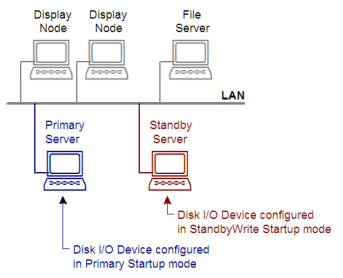
If using a network, you can configure a redundant disk I/O device to minimize the potential for data loss (in the event the server becomes inoperative). This diagram illustrates the use of redundant disk I/O devices:

When the system is operating, Citect SCADA reads and writes runtime data to the disk I/O device configured in the primary server. It also writes runtime data to the disk I/O device configured in the standby server. (Citect SCADA maintains both disk I/O devices identically.)
If the primary server becomes inoperative, the Disk I/O device in the standby server is activated without interrupting the system. When the primary server becomes active, Citect SCADA automatically returns control to the primary server, and copies the Disk I/O Device from the standby server to the primary server. The disk I/O device in the standby server reverts to its standby role.
To define a redundant disk I/O device:
For redundant disk I/O devices, you need to use Microsoft Networking (or another peer-to-peer network), and the hard disk of the standby server (the directory where the disk I/O device file is stored) needs to be shared. Use Windows Explorer to set the directory to shareable.
See Also
Published June 2018